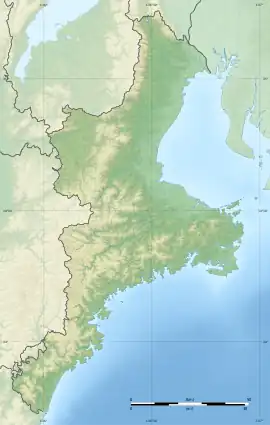Tsubaki Shrine
Tsubaki Shrine (都波岐神社) is a Shinto shrine in the Ichinomiya neighborhood of the city of Suzuka in Mie Prefecture, Japan. It is one of the two shrines which claim the title of ichinomiya of former Ise Province. The main festival of the shrine is held annually on October 10. It is also known as the Tsubaki-Nakato Jinja (都波岐奈加等神社), as the shrine consisted of two separate shrines, the Tsubaki Jinja and the Nakato Jinja, which were amalgamated in the Meiji period.[1]
| Tsubaki Shrine 都波岐神社 | |
|---|---|
 Shaden of Tsubaki Shrine
| |
| Religion | |
| Affiliation | Shinto |
| Deity | Sarutahiko Ōkami |
| Festival | October 10 |
| Location | |
| Location | 1181 Ichinomiya-chō, Suzuka-shi, Mie-ken 513-0031 |
 Shown within Mie Prefecture  Tsubaki Shrine (Japan) | |
| Geographic coordinates | 34°54′4.5″N 136°36′4.5″E |
| Architecture | |
| Founder | c.Emperor Yūryaku |
Enshrined kami
The kami enshrined at Tsubaki Shrine is:
- Sarutahiko Ōkami (玉祖命), leader of the kunitsukami and patron of martial arts such as aikido.
The kami enshrined at Nakato Shrine are:
- Ama-no-kuno-no-Mikoto (天椹野命), ancestor of the Nakato clan
- Nakatsutsuo-no-mikoto (中筒之男命), one of the Sumiyoshi sanjin
History
The origins of Tsubaki Shrine are unknown. Although there is no documentary evidence, the shrine's legend states that it was founded during the reign of the semi-legendary Emperor Yūryaku (reigned 456 to 479). Both shrines first appear in historical documentation in the Engishiki records from the early Heian period, and are classed as "minor shrines". Kūkai is alleged to have visited the shrine, and to have donated two masks for the lion dance. It is uncertain also when it began to be regarded as the ichinomiya of the province, although this is contested by Tsubaki Grand Shrine, (also in Suzuka); however by 1079 it had advanced to the highest court ranking, and was made a shrine for prayers to the imperial family by Emperor Go-Shirakawa. However, the shrine was razed by Oda Nobunaga during his conquest of Ise Province and all old records were lost. The shrine was revived by the Hitotsuyanagi clan, daimyō of Kanbe Domain during the early Edo Period.[2]
During the Meiji period era of State Shinto, the shrine was rated as a Prefectural shrine in 1871 under the Modern system of ranked Shinto Shrines.[3][4]
Gallery
 Entry with Torii
Entry with Torii Shaden
Shaden
See also
- List of Shinto shrines
- Ichinomiya
- Tsubaki Grand Shrine the other Ise Ichinomiya
References
- Plutschow, Herbe. Matsuri: The Festivals of Japan. RoutledgeCurzon (1996) ISBN 1-873410-63-8
- Ponsonby-Fane, Richard Arthur Brabazon. (1959). The Imperial House of Japan. Kyoto: Ponsonby Memorial Society. OCLC 194887
External links
 Media related to Tsubaki Nakato-jinja at Wikimedia Commons
Media related to Tsubaki Nakato-jinja at Wikimedia Commons
Notes
- Shibuya, Nobuhiro (2015). Shokoku jinja Ichinomiya Ninomiya San'nomiya (in Japanese). Yamakawa shuppansha. ISBN 978-4634150867.
- Yoshiki, Emi (2007). Zenkoku 'Ichinomiya' tettei gaido (in Japanese). PHP Institute. ISBN 978-4569669304.
- Ponsonby-Fane, Richard. (1959). The Imperial House of Japan, pp. 125.
- Okada, Shoji (2014). Taiyō no chizuchō 24 zenkoku 'Ichinomiya' meguri (in Japanese). Heibonsha. ISBN 978-4582945614.